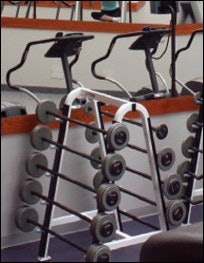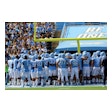Survival in times of economic uncertainty usually means boosting services, not cutting corners

No one would have thought less of Rick Brode if he had taken a look at his declining stock portfolio a couple of years ago and decided to hold off on a major renovation of his Southfield, Mich., health club. Although by Brode's own estimation the club was in need of a physical and attitudinal upgrade, if he had waited for signs of life in the local and national economies it would have been perfectly understandable.
Understandable, but wrong.
Started by Brode's dad as little more than four tennis courts back in 1969, the business had changed with the times, morphing from the Franklin Racquet Club to the Franklin Racquet Club and Spa and then to the Franklin Fitness and Racquet Club. Rick Brode took over ownership of the club in 1996 after a career as an entertainment industry attorney, and after a few years refamiliarizing himself with the family business, he knew just what to do. With the national economy in the midst of a tailspin, Brode changed the club's name to the Franklin Athletic Club, hired a consultant from the hospitality industry to help reinvigorate the club's marketing plan, and spent $4 million to, among other things, double the size of the club's fitness center.
"You've got to hit when the economy is down," Brode says of his reinvestment strategy. "It's like when a restaurant starts doing bad, and the owners start cutting portions and quality. Once that happens, I guarantee you that place will be out of business shortly."
The economic downturn that followed the dotcom collapse in 2001 hit certain segments of the club industry very hard. Clubs in and around New York City were particularly affected by the World Trade Center attacks later that year, and clubs in other markets (Seattle and San Francisco come to mind) lost members over the next year as young people moved away after losing their tech jobs.
Yet, the past few years have also seen many entrepreneurs thumb their noses at the faltering economy by entering the club business with splashy new facilities, often targeting people considered underserved by traditional clubs. In short, while the "unfair competition" issue gets a lot of press, plain-old competition between for-profit ventures is claiming its share of victims, too.
In Dallas, for example, the mood last summer among independent club owners was summed up by a story in the Dallas Morning News headlined, "Economy, Fitness Alternatives Put Squeeze on Gym Business." The anatomy of the downward spiral, according to the ex-club owners interviewed, went something like this:
1. Massive layoffs force consumers to cut back on extras such as club memberships.
2. Niche businesses, such as Curves for Women, yoga studios and high-performance personal training studios for young athletes cut into clubs' market share.
3. The first traditional clubs go belly up, and the national health-club chains that swoop in to purchase them are able to offer low-price memberships, further eroding established clubs' revenues.
In spite of dealing with a similarly competitive environment in the Detroit suburbs, Brode says the situation is not so dire as that.
"I think, even though the economy has been weak, that the club industry itself is strong," he says. "There's a very nice, brand-new Powerhouse Gym around the corner from us. The Beverly Hills Club - a nearby competitor, though we're close friends - went through a renovation about five years ago. The local Jewish Community Center just underwent a big renovation. Lifetime Fitness came in on the perimeter of town, plus we've added all these little Curves places."
And, Brode adds, it isn't just the new guys who can be entrepreneurial. In fact, a major part of Franklin Athletic Club's renovation - the addition of a North American doubles squash court - was the result of the club's responsiveness to local market forces. When the Southfield JCC announced that its renovation plan included the removal of its racquet courts, a group of apoplectic squash players confronted the facility's board, which in turn asked Brode to attend a planning meeting in the hopes that he might be able to accommodate them.
What Brode saw at the meeting wasn't so much an angry mob - "They were ready to hang the guys," he says - as it was a group of the most dedicated clubgoers imaginable. Brode agreed to add the court, and the move netted the club around 150 new memberships, according to Kelley Verbeerst, Franklin Athletic's sales and marketing director.
Such moves are what keep clubs around for a generation or more - even if that means performing a delicate balancing act between the needs of the older regulars and the differing tastes and expectations of newcomers. A good example is the Wheaton (Ill.) Sports Center, which will celebrate its 25th anniversary this year. Launched in 1979 as a tennis and racquetball mecca - it boasts 14 tennis courts, eight of which are clay - the club has survived a competition shift (as other racquet clubs have gone out of business and been replaced by fitness clubs), as well as a demographic shift in suburban Chicago.
"This is a club that over the past 25 years has been able to adapt, expand and reevaluate what the needs of the community are," says Mike Gilligan, the club's general manager. "When we started out, we had 12 or 13 racquetball courts, a piece of fitness equipment here or there, and the pool. Now we're down to three racquetball courts, and at times we use the courts for other programs, which doesn't always please our remaining racquetball players."
Initially an adults-only club, the sports center has seen its tennis-playing members age and the community become home to an increasing number of families with children. As the need for family facilities has become more apparent, the racquetball courts have become multipurpose rooms, child-care areas, group exercise studios and day-spa facilities. Says Gilligan, "The conversions are the best things we've ever done. I mean, as an existing club, you're limited to a certain extent - the facility can only be so big, the parking lot can only have so many spaces. At the same time, having the space to offer different programs at different times of the day lets you maximize the space that you have. If you look outside, you see sports cars from 5 to 8 a.m., and then from 8:45 till lunchtime it's SUVs and minivans."
One obvious word of caution: Club owners hoping to add a new revenue stream might see the stream dry up one day, meaning that changes to the physical plant should be weighed carefully. "You don't want to go too crazy with respect to saying, 'Oh, here are all the answers for $4 million, I'll be wired for the next 10 years.' " Gilligan says. "In two years you could be saying, 'Why did I ever buy a microdermabrasion machine? In 2003, it seemed like the hottest thing, all the women were paying top dollar for this kind of stuff.' "
Another good example, Gilligan adds, is tanning booths. "There are clubs putting in UV booths, but this is a time when the medical community is coming out and telling us that tanning is bad for you. And so, a lot of people are replacing their UV beds with spray-on units. If you want to invest in it, great, but who knows. In a few years there may be a tanning pill. You just don't know."
Chasing after trends during recessionary times isn't something that worries an industry veteran like Rick Caro. "I don't think we've seen fads lately in the fitness business, because the fitness business is no longer driven by any one element," says Caro, a founder of the International Health, Racquet & Sportsclub Association and of the New York City-based consultancy Management Vision Inc. "There are temporarily hot offerings, usually just one of many programs offered by a particular club, but we haven't seen the Hula Hoop of the club industry in quite some time."
What does irk Caro is that many owners react to economic downturns by performing due diligence with regard to controlling expense creep, all the while paying lip service to the equally vital revenue side of the ledger.
"As revenues become more uncertain, it is important to make sure you're maintaining your margins," Caro says. "So people go back and renegotiate with landlords, protest real estate taxes, refinance their debt, tweak their insurance coverage, put a hold on new purchases, and eliminate or cut back under-enrolled classes. To some extent they attack all the controllable variable expenses, staffing in particular."
However, Caro describes the majority of clubs' positioning as "woefully weak" in this changing marketplace. Noting that many independent clubs tend to portray in advertisements what they are not - not a meat market, not a club for elites - Caro takes this as an indication that their owners might not know who their current or potential customers are.
"Competing in uncertain times is a challenge," he says. "The number of new joiners available to all clubs may not be as plentiful or as easy to identify, so you have to figure out what your core strengths are and emphasize those, and go after people who fit the profile of those interested in your core strengths."
One measure of how uncertain times have been is that even the larger club chains, which Caro calls "sales organizations, not service organizations," have begun embracing the service message and trying to cast a wider net for members. Bally Total Fitness, the 420-club national chain, is running a new ad campaign in 2004, "Every Body Needs Something," that is focused on a greater variety of physical types than the usual Lycra-clad twenty-something. In October, Town Sports International, the 130-club Northeast chain, instituted brand-new membership options including students, senior citizens and families, which followed the chain's rollout of a Curves-like 22-minute express workout. In January, Town Sports opened its first 24-hour location (in Manhattan), which it is marketing as a haven for college students and evening- or late-shift workers.
"We've seen fragmentation of our market since the beginning of the downturn and started realizing when we looked at the demographic of our members that we were missing some market segments," says Town Sports CEO Bob Giardina. "Less than 5 percent of our membership was under 21, and less than 5 percent was over 60, and those are very large segments. So that's what's been driving those decisions."
As the chains try to broaden their appeal and take small-club bankruptcies as a cue to expand, independent clubs are boosting their service orientation as a differentiation strategy. As Gilligan says, noting the presence of two Lifetime Fitness mega-clubs in his area, "Just do the math: If they've got 13,000 members and we've got a couple thousand, chances are you're going to get a little more personal customer service, some added hospitality, with us. That sort of thing goes a long, long way."
As part of Franklin's rehab, Brode started a concierge service and began training staff in what he calls the "RitzCarlton" method. "It's the way you have to compete, I think - you have to improve the brand, improve your image, and keep hammering on it," he says.
Image-making (or remaking) is another aspect of club competition that a poor economy makes more difficult. The standard methods of getting the message out - typically television, radio and print ads - in addition to being expensive don't necessarily reach the people most likely to join a club. Direct mail, probably the most popular club advertising method, gets some first-timers using coupons as a come-on, but doesn't offer most clubs enough space to tell their whole story. And, as Caro notes, these days getting people in the door of the club is just the beginning of the battle.
"We find more people not buying on the first visit, people who maybe need to bring in their spouse before they make a decision or need to try more than one activity," Caro says. "These days, you need better sales systems of following up with and nurturing people, whether by simply talking to them about the benefits of membership or by offering them additional guest visits."
A still-underutilized technique (even though Caro has been pushing it for 30 years, since the days when he was an owner of eight clubs) is community outreach. For example, he says, a club looking to target kids or active families could assign a younger staff member to patrol the sidelines at Saturday-morning youth soccer games and invite parents and kids to visit the club. "You can talk to 20 adults in an hour, which is about as cost-efficient as any marketing technique out there, and you'll also get the value of group peer pressure," says Caro.
Local newspapers can offer a wealth of information on people with similar interests - travel clubs, church groups - and when and where they currently hold meetings. It should be a simple matter to invite them to hold their next meeting in your club. Caro recalls a preseason meeting of parents, kids and officials of a youth sports organization, held at one of his clubs, that netted eight memberships within the next 30 days. "It cost us nothing but pretzels and soda, and a racquetball court that we couldn't use for an hour and a half," says Caro. "I don't think you can do it less expensively than that."
Last summer, with the stock market making its first gains in three years and other indications of better days ahead, David Gentry moved from Eugene, Ore., to the San Jacinto Valley of southern California. Having purchased the 22-year-old Hemet Racquetball Club from its original owners, Gentry began running the club during the day and overseeing nighttime renovations, gradually transforming the space into what is now called the HRC Athletic Club.
Despite his long hours, Gentry feels the renovations have gone well, with the club's four refurbished racquetball courts now bustling with the older people that predominate in this town of 70,000. The fitness center, aerobics room, indoor pool and gym are getting spruced up, and although there are no plans to expand its 30,000 square feet, Gentry concedes the gym isn't the best use of space ("In a perfect world, it would be a giant weight room," he says).
Hemet, Gentry believes, is a perfect world for an entrepreneur such as himself. The club is well-established, retaining a number of members who remember well the many ski trips and social events organized by the previous owners. The town itself has no other clubs to speak of, and neighboring San Jacinto has just one club that you could call a competitor. Chains such as L.A. Fitness have visited and rejected the community as a future franchise location, Gentry says, because of its older demographic. "I kind of bought the club under the assumption that if you're the only club in town and you have your act together, you'll do fairly well," Gentry says.
The only stumbling block so far, Gentry reports, is the club's pricing structure. Its 2,000 members (representing 1,400 memberships sold) are "all used to paying extremely low rates," Gentry says. "I've got to figure out how to command a higher price. The club I belonged to in Eugene was $55 a month and no one thought twice about it. If you did that here, they'd all faint."
As for the economy, Gentry figures there's never a bad time to invest in the fitness business. "Our fee is the equivalent of a cable-TV bill, and if people in a poor economy won't give up their cable, they shouldn't give up their club membership, either. In my book, even if the economy is horrible, you should still be able to justify your fee to people if it helps them look better, feel better and live longer."
































